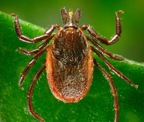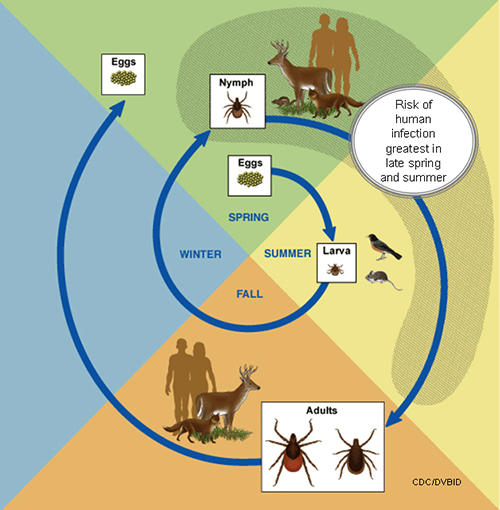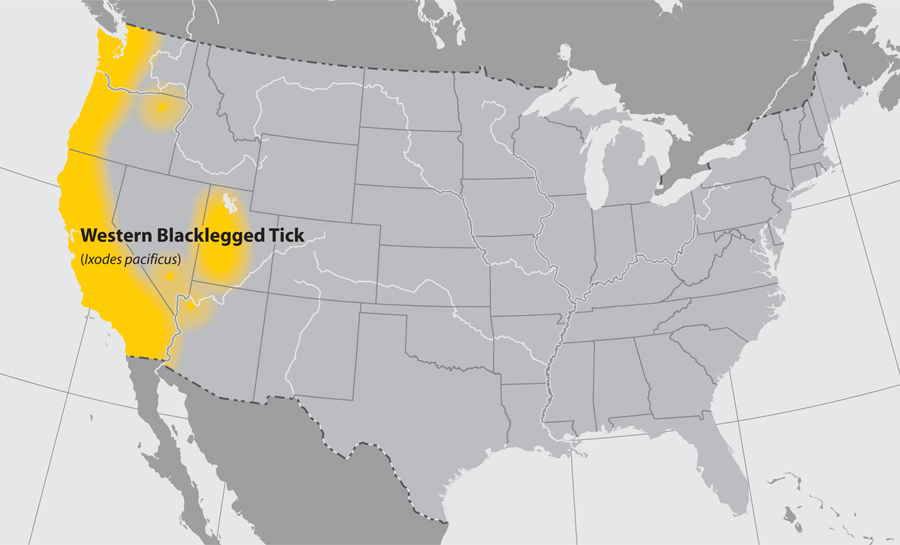Ixodes pacificus
| style="background:#Template:Taxobox colour;"|Ixodes pacificus | ||||||||||||||
|---|---|---|---|---|---|---|---|---|---|---|---|---|---|---|
 | ||||||||||||||
| style="background:#Template:Taxobox colour;" | Scientific classification | ||||||||||||||
| ||||||||||||||
| Binomial name | ||||||||||||||
| I. pacificus Cooley & Kohls, 1943 | ||||||||||||||
| File:Ixodes pacificus range map.svg |
Editor-In-Chief: C. Michael Gibson, M.S., M.D. [1]
Overview
Ixodes pacificus, the Western black-legged tick, is a species of Ixodes, a parasitic tick found on the western coast of North America. It is the principal vector of Lyme Disease in that region.[1][2]
Life Cycle
General Tick Life Cycle

- A tick's life cycle is composed of four stages: hatching (egg), nymph (six legged), nymph (eight legged), and an adult.
- Ticks require blood meal to survive through their life cycle.
- Hosts for tick blood meals include mammals, birds, reptiles, and amphibians. Ticks will most likely transfer between different hosts during the different stages of their life cycle.
- Humans are most often targeted during the nymph and adult stages of the life cycle.
- Life cycle is also dependent on seasonal variation.
- Ticks will go from eggs to larva during the summer months, infecting bird or rodent host during the larval stage.
- Larva will infect the host from the summer until the following spring, at which point they will progress into the nymph stage.
- During the nymph stage, a tick will most likely seek a mammal host (including humans).
- A nymph will remain with the selected host until the following fall at which point it will progress into an adult.
- As an adult, a tick will feed on a mammalian host. However unlike previous stages, ticks will prefer larger mammals over rodents.
- The average tick life cycle requires three years for completion.
- Different species will undergo certain variations within their individual life cycles. [3]
Spread of Tick-borne Disease
- Ticks require blood meals in order to progress through their life cycles.
- The average tick requires 10 minutes to 2 hours when preparing a blood meal.
- Once feeding, releases anesthetic properties into its host, via its saliva.
- A feeding tube enters the host followed by an adhesive-like substance, attaching the tick to the host during the blood meal.
- A tick will feed for several days, feeding on the host blood and ingesting the host's pathogens.
- Once feeding is completed, the tick will seek a new host and transfer any pathogens during the next feeding process. [3]
Geographic Distribution
- Found along the United States Pacific coast
- Most common in Northern California

References
- ↑ Chang CC, Chomel BB, Kasten RW, Romano V, Tietze N (April 2001). "Molecular evidence of Bartonella spp. in questing adult Ixodes pacificus ticks in California". J. Clin. Microbiol. 39 (4): 1221–6. doi:10.1128/JCM.39.4.1221-1226.2001. PMC 87914. PMID 11283031.
- ↑ Killilea ME, Swei A, Lane RS, Briggs CJ, Ostfeld RS (June 2008). "Spatial dynamics of lyme disease: a review". EcoHealth. 5 (2): 167–95. doi:10.1007/s10393-008-0171-3. PMID 18787920.
- ↑ 3.0 3.1 Life Cycle of Ticks that Bite Humans (2015). http://www.cdc.gov/ticks/life_cycle_and_hosts.html Accessed on December 30, 2015
Gallery
- Common name: western blacklegged tick
- Scientific name: Ixodes pacificus
- Reservoir: birds and small rodents (larvae and nymphs); deer and other mammals (adult ticks)
- Geographic distribution: Pacific coast of the United States
- Disease transmitted: anaplasmosis, Lyme disease
-
Western blacklegged tick (Ixodes pacificus)
Adapted from CDC -
Approximate distribution of the Western Blacklegged tick
Adapted from CDC